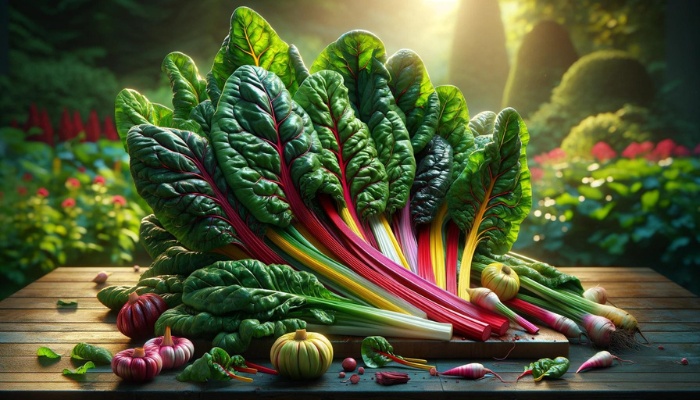In square foot gardening, you can densely plant Swiss chard—both green and rainbow types—for high yield in minimal space. Start by preparing soil with peat moss, vermiculite, and compost for optimal growth.
It’s best to plant this cool-season crop after the last frost. Sow seeds half an inch deep and 3-4 inches apart, ensuring your soil’s pH is between 6.0 and 6.8.
Water consistently, fertilize every 4-6 weeks with organic options, and use mulch to retain moisture. Harvest when leaves reach 8-12 inches, cutting outer ones first.
Adopting these techniques will maximize your garden’s productivity and reveal even more ways to enjoy your bounty.
Understanding Square Foot Gardening
Square foot gardening, an efficient method of creating small but intensely planted gardens, allows you to maximize your yield in a minimal space. This technique hinges on careful soil preparation.
You’ll want to start with a well-balanced mix, typically one-third peat moss, one-third vermiculite, and one-third compost from multiple sources.
This combination promotes strong root development and ensures your plants have access to the nutrients they need without the common pitfalls of traditional gardening.
Pest management in square foot gardening is streamlined due to the dense planting method which can naturally deter pests. However, vigilance is key.
Regularly inspect your Swiss chard for signs of pests, and implement barriers such as floating row covers to prevent infestations.
Companion planting can also be a powerful strategy; planting garlic or onions near your Swiss chard can help repel aphids and other pests.
This proactive approach to pest management preserves your garden’s health, allowing you to enjoy a bountiful harvest without resorting to harsh chemicals.
Choosing Your Swiss Chard Variety
Now, it’s time to select the Swiss chard variety that best fits your culinary preferences and growing conditions. Swiss chard, a leafy green packed with nutritional benefits, can elevate recipes while enriching your diet with vitamins and minerals.
Here’s a concise guide to help you choose the right variety:
- Bright Lights: Known for its vibrant, multi-colored stalks, ranging from gold to pink and purple, this variety adds a pop of color to your garden and dishes without compromising on taste or nutritional value.
- Fordhook Giant: This variety boasts large, crinkly, dark green leaves with white stems. It’s especially cold-hardy, making it a great choice for cooler climates or for extending your growing season.
- Ruby Red (Rhubarb Chard): With its striking crimson stems and dark-green leaves, Ruby Red not only looks beautiful but also offers a slightly sweeter taste. It is perfect for raw applications in salads or lightly cooked in stir-fries.
- Perpetual: This one is ideal for those who prefer a continuous harvest, Perpetual produces smaller, more tender leaves over a longer period, making it perfect for ongoing use in a variety of chard recipes.
Planting and Spacing Guidelines
Proper planting and spacing techniques ensure optimal growth and yield. Effective soil preparation forms the foundation of your Swiss chard’s success.
Begin by working the soil to a depth of about 8 to 12 inches, incorporating organic matter such as compost to improve drainage and fertility. Swiss chard thrives in a soil pH between 6.0 and 6.8.
For square foot gardening, Swiss chard can be planted quite densely. Sow seeds about half an inch deep, spacing them 3 to 4 inches apart in all directions within each square foot area.
This spacing allows each plant enough room to grow robustly without overcrowding.
Swiss chard is a cool-season crop, so it is best planted just after the last frost in spring. However, it can tolerate a bit of heat, making it adaptable to various climates. In regions with warmer springs, consider providing partial shade to prevent bolting.
Caring for Your Swiss Chard
To ensure your Swiss chard’s vitality and productivity, regular watering and nutrient management are essential components of care. There are specific strategies you can employ to maintain the health and yields of your Swiss chard plants.
- Consistent Watering: Swiss chard requires evenly moist soil. Water deeply when the top inch of soil feels dry to the touch. This practice encourages deep root growth, enhancing the plant’s resilience against dry spells.
- Fertilization Tips: Apply a balanced, organic fertilizer every four to six weeks. Swiss chard benefits from nutrients like nitrogen for leaf growth, but overfertilization can harm plant health, so adhere to recommended rates.
- Mulching: Apply a layer of organic mulch around your plants. Mulch conserves moisture, regulates soil temperature, and suppresses weed growth, all of which contribute to healthier Swiss chard.
- Disease Prevention: Keep an eye out for signs of disease or pests. Practice crop rotation, and ensure good air circulation around your plants to minimize the risk. Remove and dispose of any affected plant parts promptly to prevent the spread.
Harvesting and Enjoying the Bounty
When your Swiss chard’s leaves reach a desirable size, typically 8-12 inches in length, it’s time to start harvesting.
The best method involves cutting the outer leaves first, about 1-2 inches above the ground, allowing the inner leaves to continue developing.
This technique not only ensures a steady supply of fresh chard but also encourages the plant to produce new leaves.
After harvesting, you’ll want to explore various chard recipes to fully enjoy your bounty. Swiss chard can be sautéed, added to soups, or used in salads. Its versatility in the kitchen is one of its greatest assets.
For a longer shelf life, consider preservation methods such as blanching and freezing. This process involves briefly boiling the leaves, then plunging them into ice water to halt the cooking process, followed by drying and freezing.
This method preserves the nutritional value and taste, ensuring you can enjoy your Swiss chard year-round.

